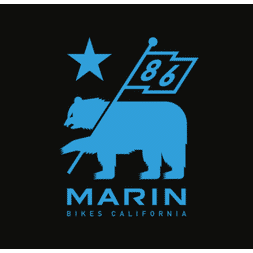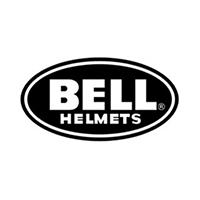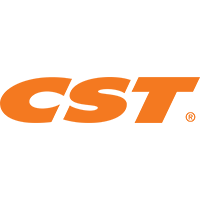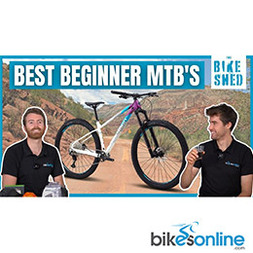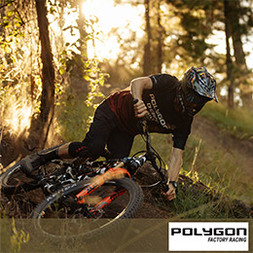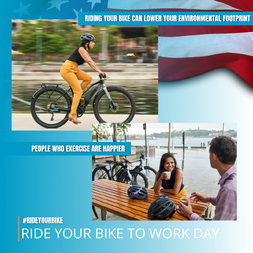The Anatomy of a Bike
To learn more about all the different components of a bike, please read the article below.
As simple as a bike can be, a lot of the terminology and names can be quite confusing. This piece will talk you through the bike parts and terms used when describing bike parts and the areas on a bike. We will start from the front and work out way back, going through every major component.
.jpg)
Frame, front triangle, rear triangle
When describing a bike, you will often hear the frame referred to as the front and rear triangles. The front triangle refers to the top tube, down tube and seat tube. The way a bike fits the rider is determined by the measurements of these tubes. The front triangle houses the bottom bracket and most of the suspension components on an Mtb.
The rear triangle was traditionally attached to the seat tube, and it comprised the seat stay and chainstay. While this is still relevant to hardtails and road bikes, the rear triangle isn’t fixed on a dual-suspension system. The seat and chainstays are attached to links on the seat tube. The rear triangle is essentially floating, which allows the rear wheel to travel up and down.
.jpg)
The Headset
The "headset" refers to the bearings in the head tube which allow the fork to rotate in the frame. Without these bearings, you wouldn't be able to turn the handlebars.
Headset bearings don't just come in one size, unfortunately. Thankfully our My Garage system will be able to point you in the right direction.
.jpg)
Some common symptoms that your headset bearings need replacing are a knocking or “crunchy” feeling when you turn your handlebars. A creaking or knocking sound can be heard when the bearing is contacting directly with the “cup” that holds the bearing in place. Lubing the interface of the bearing and cup with high-quality grease can fix this issue.
If you ever remove the forks or the bearings and they are no longer a solid unit, they need replacing asap. If you feel any of these fixes are beyond you, any good local bike shop will be able to help.
.jpg)
Head Stem
.jpg)
The head stem is one of the most basic parts on a bike; however, it can cause a dramatic effect on the handling characteristics and a bike fit.
.jpg)
On an MTB, a stem length between 35 and 70mm. Any longer and the bike's steering will feel sloppy and slow. Longer stems can also set a rider's weight over the front angle. When heading down a steep trail, it can cause a rider to be pitched too far forward, so a shorter stem is used.
A longer stem will help stop the front wheel from rising when climbing up a steep trail. Some Xc riders will also have a negative rise stem to get their weight forward and low for pure climbing efficiency.
On a road bike, stem length is used to adjust a rider's fit within reason. Most road bikes use a 90-110mm long stem. You will see pro riders with smaller frames and longer stems to maintain a short, stiff and agile wheelbase. You will also notice their stems are extremely low to get their body in the best aerodynamic position and maintain a good climbing position. We wouldn't recommend mimicking an extreme body position and riding style unless you are 100% sure.
.jpg)
It is more important for most riders to be in a comfortable position that they can ride in at all times as they are rarely racing. If you feel stretched and are reaching for the bars, try a shorter stem. If you are cramped and feel like you are too upright, a longer stem may help.
Handlebars
.jpg)
While handlebar width is extremely important to the bike's handling, bar height is just as important yet often overlooked. Bar width will change how stable a bike feels; wider will add stability, while narrower will speed up the steering.
If the bars are too wide, you may find it difficult to move the bike around effectively because your arms are extended, and the range of movement will be diminished. Because you have to move the bars further to make a significant change in direction, this adds stability. Still, it requires more input from riders when they need to make the bike change direction faster.
.jpg)
Narrow bars make a bike more agile and speed up the handling but to the detriment of stability. If the bars are too narrow, it can make a bike twitchy and erratic. If it is too narrow, you may also find it difficult to breathe as your chest will be closed up.
It is best to aim to match your bar width to your shoulder width with 2cm added. When experimenting with bar width is best by starting wide and trimming fractionally. You can always take more off but, you can't add more on.
Front Thru-Axle
.jpg)
Rockshox tends to use their own standard called the Maxle, which is available in a quick release or stealth (Allen key) style screw in the axle on mountain bikes. Fox use their standard QR style with their floating axle design or a “Kabolt” Allen key bolt with a pinch axle. Suntour uses their Q-Loc system that differs from both and is as simple as pushing the axle through and closing the lever. All axles are now 15mm thick and will work with a majority of hubs as long as the width is compatible. The two major widths are 100mm and 110mm, with all new bikes using the latter.
.jpg)
Road bikes with rim brakes use a standard 9mm QR that has been on bikes for years. They are light, easy to use and fairly common sizes. Newer road bikes that have disc brakes use a 12mm thru-axle for safety. Although they use the same width hubs across all bikes, each axle is specifically designed for the brand and their fork. It is not as simple as buying any axle. However, we offer you the right axles in “My Garage” and tech documents.
.jpg)
Hubs
Hubs are the heart of a wheel, and while they may seem simple, there are a few different variants. Front hubs are available in multiple widths, axle sizes and brake styles. The standard quick release axle is a 9mm axle that is 100mm wide. This is common for all road bikes with calliper brakes. You can get a 100mm wide hub with a 12mm thru-axle for road and a 15mm axle for “non-boost” MTB forks. Some older bikes predating 2009 will have a 20mm axle. Boost refers to a 110mm hub width available in a 12mm axle for road and 15mm thru-axle for MTB.
Rear hubs are available in “boost” and “non-boost”. Boost hubs are 148mm wide and use a 15mm thru-axle in MTB or a 12mm axle in road bikes. “Non Boost” hubs are 142mm wide and come in 9mm, 12mm or 15mm axle widths. A rare standard called “super boost” uses the older DH standard of 157mm wide hubs, but this is a very niche hub size.
.jpg)
Free Hubs
The gears on a rear hub slide onto a part called a "freehub". There are 4 major styles of freehubs that relate to the brand of the drivetrain. SRAM, Shimano and Campagnolo all use different freehub splines to hold the cassettes. The only common one shared between a few brands is Shimano's "Hyper glide" freehub. Used for most 8/9/10/11 speed cassettes from SRAM or Shimano, where the smallest gear has 11 teeth.
.jpg)
SRAM pioneered using a 10 tooth gear as the smallest gear on their first 11-speed wide-range cassette. The major change that allowed such a small gear was the XD driver. An XD driver has no splines, and the cassettes screw directly onto the freehub. SRAMS 12-speed eagle drive train on mountain bikes still use XD however, the AXS 12 speed on-road uses XDR. Srams NX and SX level 12 speed cassettes still use an HG freehub; however, you will only get an 11 tooth small gear.
.jpg)
Shimano has used the HG freehub for many years now, but there are some variants. All 8,9, and 10-speed cassettes fit the same HG freehub body. 11-speed road cassettes are 1.85mm wider and require the wider 11 speed HG freehub body. 8,9 and 10-speed cassettes will fit the 11-speed hg freehub with the right combination of spacers. Shimano 12 speed uses a "Micro spline" freehub to use a smaller 10 tooth cog. Micro spline freehubs ONLY work with Shimano 12 speed cassettes.
.jpg)
.jpg)
Campagnolo is a niche Italian groupset that uses its own freehub for both 12 and 11-speed drive trains. As this is not on any of our bikes, there is no need to go into detail; however, if you plan on upgrading to Campagnolo on a road bike, please reach out to our service team if you have any questions.
.jpg)
Brakes
Brakes come in 2 major styles with 4 subcategories. The first style is the rim brake which uses rubber pads to clamp the rim and slow the bike. The second style is a disc brake which uses callipers to clamp pads on a disc attached to the hub. The final style is kickback or coaster hub brakes which expand brake shoes inside the hub to slow the bike down.
.jpg)
Rim brakes are available in the V-brake style and the U-Brake style. Most bikes that are used off-road and may experience the tyres getting muddy use V-Brakes. This is because V-Brakes sit further away from the tyre and the chances of them getting clogged by debris are low. V-Brakes also use larger pads on larger levers to clamp the rim, so they are naturally more powerful.
U-Brakes only allow a maximum tyre width of 28mm, so they are specifically on high-performance road bikes. They are light, have excellent modulation and are super powerful. With the advancement of wheels and the increasing use of carbon fibre rims, U-brakes started to show their weakness. Excess heat can damage a carbon rim, and the braking surface is smooth, so there was decreased performance.
.jpg)
Disc brakes are available in hydraulic or cable variations. Cable discs are operated by a brake cable and are the cheaper, more basic option. The simplicity leads to reliability and easy serviceability. They perform amazingly in commuting and light off-road use thanks to their ability to clear water or debris easily.
Hydraulic discs are essentially the same technology as what your car or motorbike use in a smaller package. Hydraulic discs offer supreme power, greater modulation and reliability. Unfortunately, they are a little tougher to work on and bleeding the system requires special tools. These are for you if you are riding aggressive MTB, fast road descents, or just want powerful brakes.
Discs come in two different mounting styles, 6 bolt and centre lock. The style of disc you use is dependent on the hub's mounting style. We have provided pictures below to show you the differences.
.jpg)
Derailleurs
Front or rear derailleurs are often also referred to as mechs. They are the components responsible for shifting the chain between gears. Although SRAM and Shimano both have the same gears on many drivetrains, the parts are not interchangeable. A Shimano shifter won’t work with a SRAM rear derailleur and vice versa.
.jpg)
Derailleurs are also specific to the number of gears on the cassette. You can only use a 12-speed mech on a 12-speed cassette, an 11-speed mech on an 11-speed cassette and so on.
The amount of teeth you have on the largest cog also determines the rear mech you can use. If you have a 32 tooth cassette, then a derailleur only rated to a 30 tooth will never work effectively. So make sure when you are upgrading or changing the cassette/rear mech, you notice their limitations.
.jpg)
Tyres
Road bike tyres have evolved massively over the last 5 years, with many riders finding that bigger can be better. The measurements seem confusing but are actually quite simple. The most common wheel diameter is 700mm, and they often run a 25-45mm tyre width range. 650b wheels have gained some popularity in the gravel market over the last few years thanks to bigger tyres that add comfort and traction.
.jpg)
High-performance road bikes will run a 25-28mm tyre width that balances comfort and performance. Modern road bikes come with 28-35mm widths for extra comfort and traction on rougher roads and longer rides. Gravel and cyclocross run 33mm to 50mm, often with knobs for extra traction.
The “C” you see on tyres just relates to the fact it is a clincher tyre. This label is almost redundant as most tyres are clinchers and no longer tubular like the old days.
If you look at your tyres, they will say 700x32c, 650X50c or 700x28c, all depending on the tyres you have. The first number relates to the wheel diameter, and the second is the width. These are the only numbers worth noting on the tyres.
.jpg)
Mountain bikes use inches for some unknown reasons but, it is what it is. Many years ago, the most common size was 26 inch. In the modern-day, 27.5 and 29 inch are the most common.
MTB tyres will read a 29 or 27.5x 2.1/2.25/2.3/2.4/2.5/2.6, with the second number being the tyre width at the knobs. Bikes like xc bikes will only accommodate a maximum width of 2.3. Trail and enduro bikes use a 2.3-2.6 wide tyre. If you want more traction, better tracking through the rough and more comfort, then a wider tyre will give you that.
.jpg)
Tyre compounds are a whole different topic that we will discuss in a different blog.
.jpg)
Bottom Bracket
The bottom bracket refers to the bearings that retain the crank spindle in the frame. When cranks were a 3 piece component where the two crank arms were attached to a common spindle, the bottom bracket was a separate component that included the spindle.
.jpg)
Modern 2 piece cranks have the spindle permanently attached to one of the cranks. Bearings are either pressed or screwed into the frame, and the spindle slides through the bearings. This has made the components cheaper, better quality and much more reliable.
.jpg)
Due to the extra stress bottom brackets encounter from dirt, stress and lack of cleaning, they can be a major noise source. To avoid any noise or issues, it is important to keep the bearings lubricated, clean and maintained to the best of your ability. They are a disposable wear item, so it isn’t uncommon to replace them regularly.
.jpg)
The Seat Post
Like many other components, the humble seat post has undergone numerous changes over the years. There is no such thing as one standard size, and there are dropper posts to consider as well. Finding what diameter seat post you need is simple as it is stamped into the post. If you simply pull the post out, you will find the diameter on the back.
Dropper seat posts are the greatest invention since the wheel for mountain bikes. At the flick of a lever, you can lower the post from your optimum pedalling seat height to a position better suited to descending.
The amount of drop can vary from 125mm to 200mm for most brands. It is often advised that you find the most amount of drop that accommodates your maximum seat height. If you are unsure what is best for you, reach out to our experienced support team.
Suspension linkages
While specific to MTB, Suspension linkages are important to ensure they are torqued to spec often. A loose linkage or pivot bolt will be noisy and cause extra flex in the frame and hinder suspension performance or cause damage. Keeping them tight and clean will expand your frames lifetime by years.
Leave a comment
- Training Tips for a Beginner Cyclist
- Industry Reviews
- Bikepacking 101
- Worth-it Blogs EP#2: Hardtail Hitters
- Bikes Online Does Sea Otter
- EWS #5: Burkville
- Drop bar Buyer's Guide
- The Bicycles Online's Company Fitness Challenge
- Sustainable Strategies
- Mountain Bikes Buyer's Guide
- Worth-it Blogs EP#3: Budget Hardtail Upgrades
- Commuter Bike Guide
- Pinned With Polygon | The gang goes to Crankworx
 USA
USA AUS
AUS





